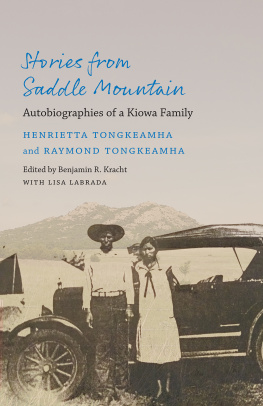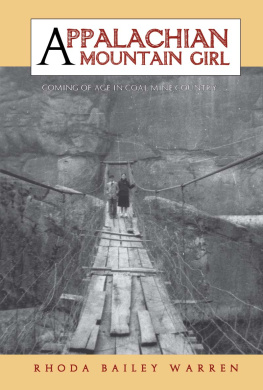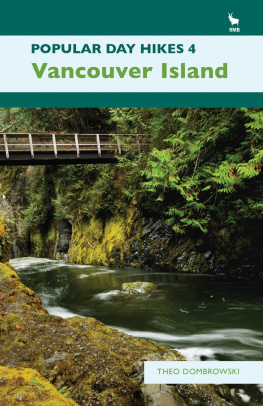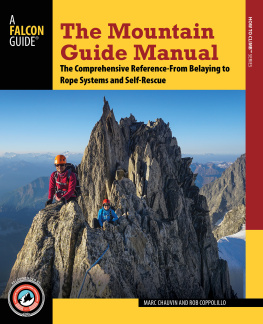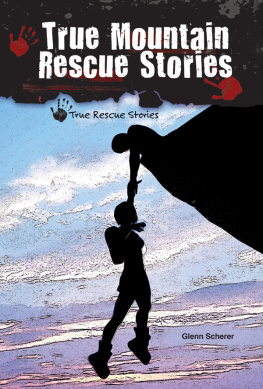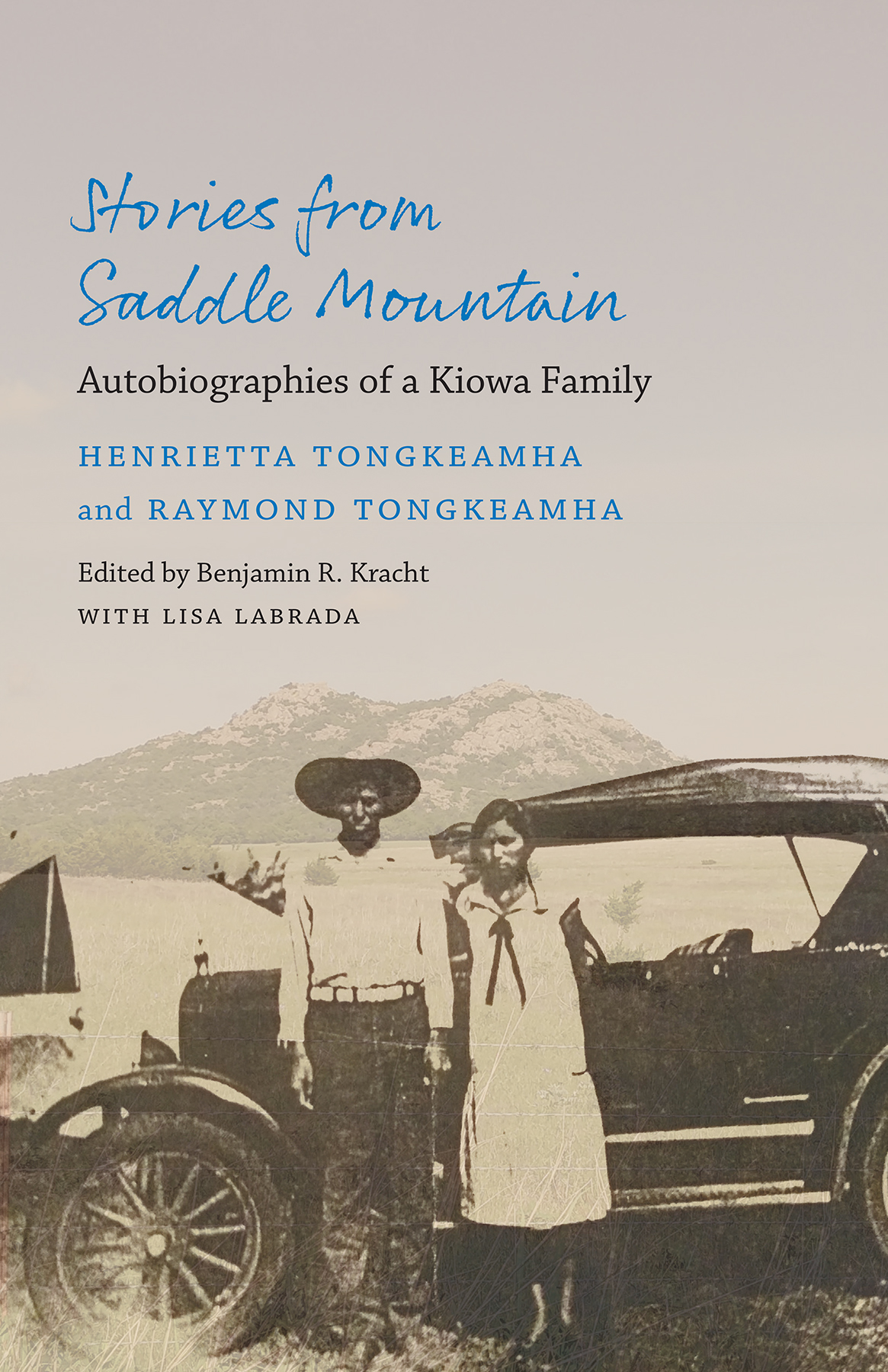
Taking the reader to the heart of Kiowa country in southwestern Oklahoma, Benjamin Kracht shares the life stories of a Kiowa mother and her son with sensitivity, grace, and great respect for the old ways. These intergenerational stories recall the warmth of a grandmothers kitchen, beadwork, boarding school days, hunting, fishing, and baseball.
Patricia Loughlin, author of Hidden Treasures of the American West
The memoirs provide resonant details about Kiowa culture and history that shine through recollections about place, kinship, friendship, hardship, and fun [and] reveal much about education, medicine, religion, technological change, and ethnic interactions in twentieth-century Kiowa country.
J. Justin Castro, author of Radio in Revolution: Wireless Technology and State Power in Mexico, 18971938
An important primary source and a superb addition not only to the scholarly record but also to Native American oral histories.
David C. Posthumus, author of All My Relatives: Exploring Lakota Ontology, Belief, and Ritual
American Indian Lives
Series Editors
Kimberly Blaeser
University of Wisconsin, Milwaukee
Brenda J. Child
University of Minnesota
R. David Edmunds
University of Texas at Dallas
K. Tsianina Lomawaima
Arizona State University
Stories from Saddle Mountain
Autobiographies of a Kiowa Family
Henrietta Tongkeamha and Raymond Tongkeamha
Edited by Benjamin R. Kracht
With Lisa LaBrada
University of Nebraska Press | Lincoln
2021 by the Board of Regents of the University of Nebraska
Cover designed by University of Nebraska Press; cover image is from the interior.
All rights reserved
Library of Congress Cataloging-in-Publication Data
Names: Tongkeamha, Henrietta, 19121993, author. | Tongkeamha, Raymond, 1942 author. | Kracht, Benjamin R., 1955 editor. | LaBrada, Lisa, contributor.
Title: Stories from Saddle Mountain : autobiographies of a Kiowa family / Henrietta Tongkeamha and Raymond Tongkeamha ; edited by Benjamin R. Kracht ; with Lisa LaBrada.
Description: Lincoln : University of Nebraska Press, [2021] | Series: American Indian lives | Includes bibliographical references and index.
Identifiers: LCCN 2021001172
ISBN 9781496228116 (hardback)
ISBN 9781496228789 (epub)
ISBN 9781496228796 (pdf)
Subjects: LCSH : Kiowa IndiansBiography. | Tongkeamha, Henrietta, 1912 | Tongkeamha, Raymond, 1942 | Kiowa IndiansOklahomaSocial life and customs20th century. | Saddle Mountain Region (Okla.)Biography. | BISAC : SOCIAL SCIENCE / Ethnic Studies / American / Native American Studies | HISTORY / Indigenous Peoples of the Americas
Classification: LCC E 99. K 5 T 664 2021 | DDC 978.004/97492dc23
LC record available at https://lccn.loc.gov/2021001172
The publisher does not have any control over and does not assume any responsibility for author or third-party websites or their content.
Dedicated to the Tongkeamha family
For my children, Robert and Elena
Contents
Late one Sunday morning in early February 2020, southwestern Oklahoma temperatures soared in the eighties as Raymond Tongkeamha and I sat inside Cache Creek United Methodist Churchten miles southeast of Carnegiewaiting for the service to begin. Almost ten years had passed since I last attended this rural Kiowa church for the funeral of my friend Dorothy Tsatoke Gray, and I was pleased to see that her son Cecil continued to hold services in her church. This day was especially joyous because everyone was gathering to celebrate the eighty-ninth birthday of renowned artist Chester Horse. Before the service began Raymond introduced me to Chester and informed him that we planned to publish an autobiography about the Tongkeamha family. Without hesitation Chester told Raymond, Tell him everything! As I reflect on Chesters encouraging words, I see that this project has been an enjoyable experience since its inception.
I am grateful to Lisa LaBrada for making her mothers memoirs available and to Raymond Tongkeamha for sharing his personal writings; their overwhelming support helped bring this project to fruition. Ethnographic fieldwork in May 2018 was funded by a Phillips Fund grant. Thanks go to Linda Musumeci, director of grants and fellowships at the American Philosophical Society, and to Daniel Swan and Christina Burke. As always, Henrietta Nelson at Holiday Inn Express ensured my stays in Lawton were comfortable. Claudia Lewis and Mary Joyce Swanda, director of the Apache Historical Society, and Tommie Riley, director of the Kiowa County Historical Society, kindly shared information and photographs of local landmarks. Christine Hallman, from the Department of Geography and Political Science at Northeastern State University, generously made map 1, for which I am thankful. Arnold Krupat and Alice Kehoe graciously provided critiques to strengthen the manuscript. I appreciate their helpful comments and constructive criticisms. Finally, special thanks go to Matthew Bokovoy and Heather Stauffer at the University of Nebraska Press for making this a pleasurable experience.
Kiowas have lived near mountains for time immemorial. Today at least half of the thirteen thousand enrolled members of the Kiowa Tribe of Oklahoma live north of the Wichita Mountains in the southwestern part of the state. Saddle Mountain, the northeastern sentinel of the Wichitas, is important to many Kiowa families, including the Tongkeamhas, who are spiritually connected to the surrounding countryside and have deep-rooted ties to a mission church about a mile north of the mountain. According to Raymond Tongkeamha, You know, I dont think or know if theres any other place on earth that is more sacred or important to me than Saddle Mountain Kiowa Indian Baptist Church. And/or thirteen and a half miles south of Carnegie, Oklahoma. Tongkeamha Place. It, Saddle Mountain, is sacred ground to me. Several years ago Raymond decided to share stories about life in these sacred grounds and began writing his life story. Around the same time his sister produced a copy of their mothers memoirs, written almost a half century earlier. Together their autobiographiespresented forthwithrelate stories about twentieth-century life in the Saddle Mountain countryside.
To appreciate the terrain around Saddle Mountain, I suggest driving fourteen miles northwest of Meers Store on State Highway 115, a zigzagging two-lane highway running between the red-hued Wichitas to the southwest and the limestone ridges of the Slick Hills to the northeast. North from Saddle Mountain the prairie opens up between Saddle Mountain and Pecan Creeks, which originate in the Slick Hills and meander northward toward the Washita River. Cottonwood, pecan, cedar, blackjack oak, elm, hackberry, walnut, mesquite, and chinaberry trees line the watercourses. Extending northwest are the solitary limestone tumuli of Longhorn Mountain, Unap Mountain, and Rainy Mountain. To the northeast Bally Mountain and Zodletone Mountain represent the northernmost extension of the Slick Hills. Deer, elk, rabbits, coyotes, bobcats, and feral hogs populate the countryside, while quail, owls, scissortail flycatchers, eagles, hawks, buzzards, and other fowl soar above. During warm spring afternoons one might espy a bull snake or rattlesnake slithering across the road.
In the late seventeenth century, Kiowas migrated southeast from the Bitterroot Mountains in Montana to the plains in search of a new equestrian lifestyle. Toward the end of the next century, they reached the Black Hills, where Lakotas and Cheyennes pushed them farther south to the Southwestern Plains (see Ortman and McNeil 2017, 910). Since then the Wichita Mountains and Slick Hills have been prominent features of ancestral Kiowa homelands. Upon conclusion of the Red River, or Southern Plains, War in May 1875, the Kiowas and their Comanche and Plains Apache allies were confined to the 2.8 million acre KCA Reservation in present-day southwestern Oklahoma (Kracht 2017, 3539). By the end of the nineteenth century, every Kiowa received a 160-acre allotment, according to the provisions of the October 1892 Jerome Agreement that opened reservation lands for homesteading. Kiowa families led by Lucius Aitson, Domot, Odlepaugh, Spotted Horse, Kokom, Tonemah, Longhorn, and others chose their parcels near Saddle Mountain. After the August 1, 1901, Opening, non-Indian homesteaders settling in the Saddle Mountain area engaged in agriculture and commerce. Neighboring communities sprang up: Boone, Alden, Hatchetville, and Broxton to the northeast; Cooperton to the west; and Sedan to the northwest. Larger towns appeared: Lawtonthe largestthirty-eight miles southeast; Apache, twenty-three miles east; Gotebo, twenty-three miles northwest; Mountain View, seventeen miles north; Carnegie, twenty-two miles north; Fort Cobb, thirty-one miles northeast; and Anadarko, forty-two miles northeast.
Next page
